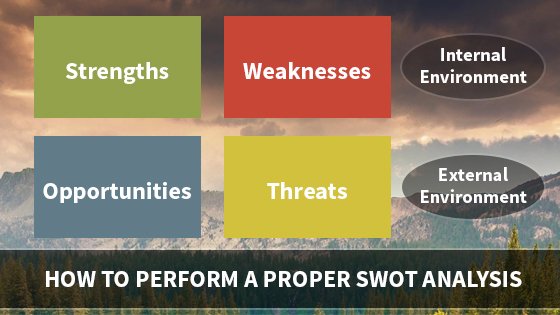
Evaluating your organization’s strengths, weaknesses, market opportunities, and threats through a SWOT analysis can be very fruitful. With this simple yet powerful process, you can get insight into the potential and most vital matters affecting your business.
What is SWOT analysis?
SWOT is a business management tool for documenting internal strengths and weaknesses in an organization, as well as external opportunities and threats. The SWOT framework is categorized into strengths, weaknesses, opportunities, and threats.
By performing a SWOT analysis, you will get information on the internal as well as external factors that may help or hold back your business success. Your management team can then use this information to establish realistic business goals and detect holes in your business plan.
When should you perform SWOT analysis?
Conducting a SWOT analysis is not that complex and can be done on a daily basis, however, this is not a smart move as the results of the analysis will need to be modified with the changes in the company and the particular industry. As a result, strategists will spend so much time conducting the analysis each time new information becomes available.
To reap the benefits of a SWOT analysis, strategists need to decide the right time to carry out the process. SWOT analysis comes into play during the following instances:
Strategic planning phases
Organizations that set time to reflect on strategic initiatives can use the time to carry out the exercise. The strategist can take inventory of what the organization can do given their resources and the opportunities and threats in their particular industry.
Introduction of new products by competitors
When a competitor introduces a new product, you can use SWOT framework to formulate a reactive strategy to compete given the prevailing industry dynamics.
Opportunities within the industry
SWOT framework can be used to assess the organization’s strengths to take advantage of the opportunities available in the industry. By matching the firm’s strengths and weaknesses with the opportunities and threats within the industry, an organization is in a better position to formulate a strategy to counteract the competitor.
Who should perform SWOT analysis?
SWOT analysis can be conducted by a single person or a group of people. But since the process involves a broad range of perspectives and valuable insights, it is advisable that the exercise is carried out by a team of people with different points of view and responsibilities within the organization. An effective SWOT analysis should be done by members from all areas of your organization including marketing, customer service, sales, and design.
But how do you perform a proper SWOT analysis?
The right way to perform a SWOT analysis
Whether done by a single person or a group of people, SWOT analysis involves these basic steps.
• Performing a situational analysis to determine the weaknesses and the strengths of the organization
• Gathering external information to identify the potential threats and opportunities
1. Decide on the purpose of your SWOT analysis
The first step is to identify the purpose of the exercise. All the members involved in the process should approve of the objective. This step is critical and should be conducted with great care. All the resultant phases are based on this first step, and if the identified objective is inaccurate, then the organization will seriously be affected regarding wastage of resources.
2. Understand your business, market, and industry
You will need to research in order to understand your business, market, and industry. Talk to your employees, business partners and clients to understand your situation. Additionally, you can carry out market research to learn more about your competitor’s activities.
3. Make a list of your organization’s strengths
What makes your business remarkable? This is the phase where you identify and list your organization’s advantageous attributes. These strengths are within your control. Examples could include strengths relating to:
• Employees (education, knowledge, backgrounds, contacts or credentials)
• Resources (equipment, capital, established customers, credit, existing channels of distribution, patents, copyrighted materials or processing systems)
• Your business location
• Cost advantages
You do not have to go into details at this stage of SWOT analysis; a list of the strengths is just fine.
4. Make a list of your organization’s weaknesses
Weaknesses are the negative characteristics that are internal to your organization. Do not fold when considering your organization’s weaknesses. List all the things in your business that you consider to be weaknesses. Also take into account the qualities of your competitors that your firm lacks. Weaknesses could include:
• Poor location
• Inferior service offerings
• Staff absenteeism
• Lack of brand recognition
• Lack of access to skills or technology
• Lack of expertise
Weaknesses are the negative factors that put you at a competitive disadvantage. They are the areas that you must do something about to be at par with your competitors. Therefore, the more accurate you identify your weaknesses, the more valuable the exercise will be for your assessment.
5. Make a list of potential opportunities for your organization
Opportunities are external to your organization since they exist in the market. So in this phase, your team should focus on the external opportunities. If you identify an “opportunity” that is internal to your business and is within your control, it is best that you classify it under your organization’s strengths. Opportunities may be the result of:
• New technology
• Trends within your industry
• Changes in government policy
• Partnerships
• Training programs
6. Make a list of potential threats to your business
Threats are external factors that you have no control over. They are the features of the market that may put the success of your business at risk. Examining these risks helps you to formulate a contingency plan to address the risks if they should occur. What factors are potential threats to your organization? They may include:
• Actions of competitors
• Higher interest rates
• Increasing market saturation
• A shift in consumer behavior that affects your sales
• Economic conditions
• Changes in laws and regulations
• Intolerable price increases by suppliers
For the exercise to be successful, classify your organization’s threats according to their gravity and probability of occurrence. Being able to identify the threats enable you to proactively plan for and respond to threats that might occur in the future.
Establish priorities from the SWOT
Prioritization
The strengths and weaknesses of an organization are evaluated by importance, rating, and score.
Importance
This shows how important a strength or a weakness is for the company in its particular industry. A number from 0.01 to 1.0 is assigned to each strength and weakness.
0.01 – not that important
1.0 – very important
Rating
Each factor (strength or weakness) is given a score from 1 to 3.
1- minor strength/weakness
3 – major strength/weakness
Score
The score of different factors is determined by multiplying the importance by rating.
On the other hand, opportunities and threats are prioritized by importance, probability and score.
Importance
To what degree do the external factors affect the organization? The level of importance shows the impact of a given factor. Usually assigned numbers from 0.01 – no impact to 1.0 – very high impact.
Probability
This shows the possible impact an opportunity or threat will have on the organization. Usually rated from 1 – low probability to 3 – high probability.
Score
Multiply the importance and probability to get the score by which you will prioritize the opportunities and strengths. Focus on factors with the highest score since they will have a greater effect on your organization.
By now you should have a list of your organization’s strengths, weaknesses, opportunities, and threats. You can place these lists side-by-side so that you can have a clear picture of the state of your business and the issues that need attention. Go ahead and develop a prioritized list of issues that are the most important and the ones that can be dealt with later.
Formulate a strategy to address issues in the SWOT
Look at your prioritized list and ask yourself these questions:
• What is the best way to use the strengths to explore the opportunities identified?
• How can the strengths be useful in overcoming the threats identified?
• As an organization, what do we require or what should we do to overcome the identified weaknesses to explore these opportunities?
• What is the best approach to minimize our weaknesses to overcome the identified threats?
The right way to perform a SWOT analysis: Mistakes to avoid
Certain errors might affect the outcome of a SWOT analysis. They include:
• Starting SWOT analysis process before identifying and agreeing on the objective of the exercise
• Setting the same management approach for strengths and opportunities
• Confusing strategies with the SWOT matrix
Now that you have learned how to perform a SWOT analysis, you can now use this technique to formulate strategies for achieving your organization’s objectives.
Contact Intigro
We love stories and would like to hear from you!
Obviously, there are no guarantees of success; however, if you do the above, your chances for success are improved.
If you are considering launching a business or growing your ongoing company, check out Dear Mr. A for creating a strategy around your passions. The Next Level Navigator strategy process is a great crowdfunding tool! Click here to look inside Dear Mr. A.
Why not tell us about how you balance work life? Please do so, either in the comments below or by submitting a guest post to us. We review these posts carefully, and as long as your contribution adds something to the entrepreneurial community we’d be happy to feature it on our site with a link back to yours!



